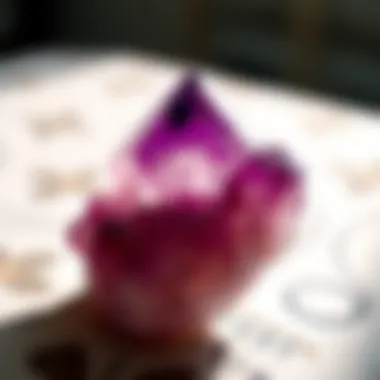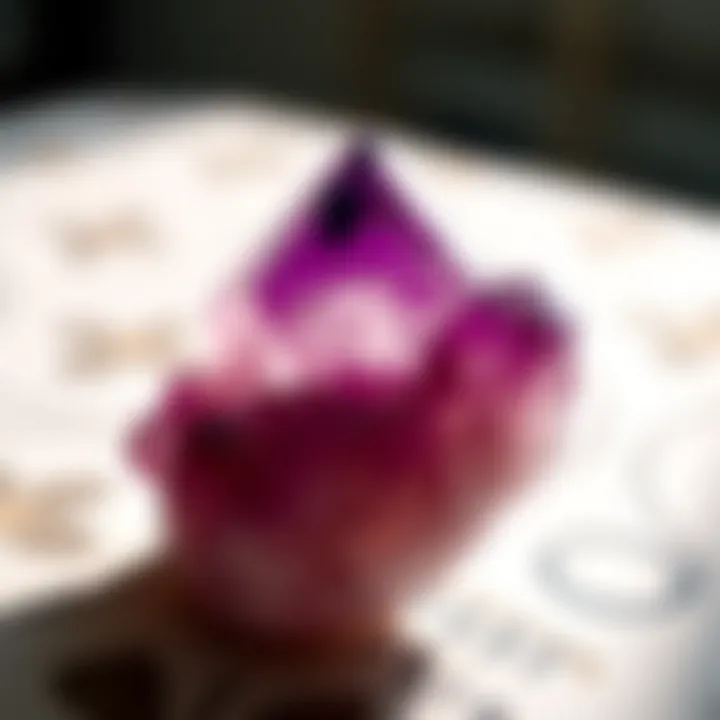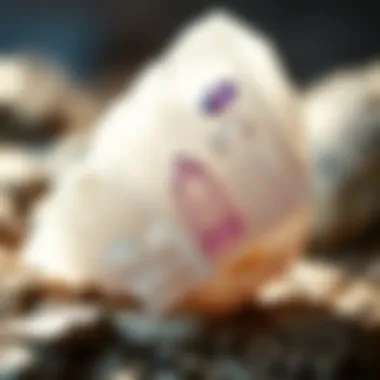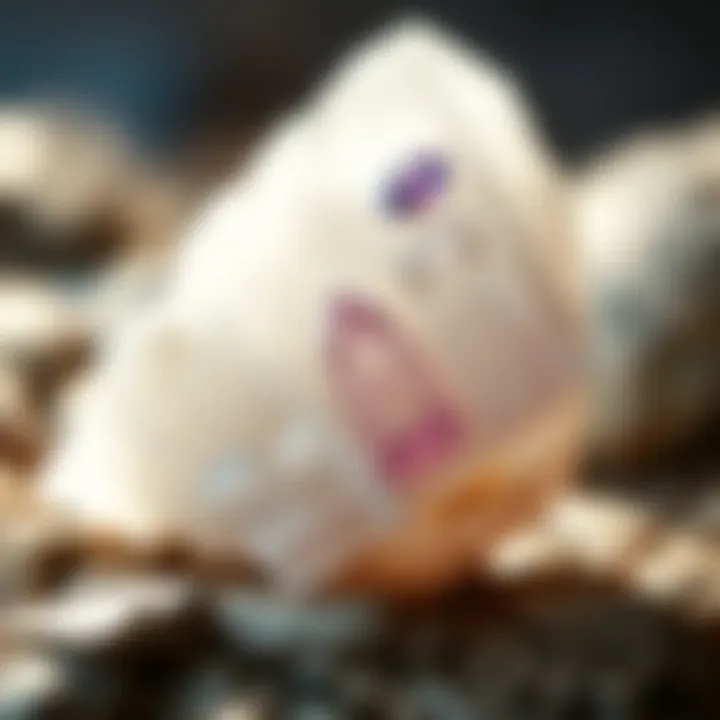Locating Crystal Rocks: An In-Depth Guide


Intro
Crystal rocks, admired for their beauty and unique properties, have fascinated humanity for centuries. They populate the land and have been utilized in various ways, ranging from decorative jewelry to their use in holistic practices. Understanding how to find these gems, whether in nature or through commercial means, is an adventure many enthusiasts embark upon. In this guide, we will cover how to locate crystal rocks, delve into geological factors influencing their formation, and discuss responsible collecting practices that honor both the environment and the hobby.
Gemstone Overview
Definition of Gemstones
Gemstones are naturally occurring minerals or rocks, often valued for their beauty, durability, and rarity. They are typically cut and polished for use in jewelry, ornamentation, or display purposes. The world of gemstones is diverse; some are transparent, while others exhibit captivating colors, patterns, and phenomena, making them endlessly fascinating.
Classification of Gemstones
Gemstones can generally be classified into two broad categories: precious and semi-precious. This classification often depends on their rarity and aesthetic appeal. Precious stones include diamonds, rubies, sapphires, and emeralds, known for their exceptional quality and cost. Semi-precious stones encompass a wider variety, such as amethyst, garnet, and quartz, providing ample choices for both new and seasoned collectors happily.
Characteristics of Gemstones
- Color: One of the most striking features, influenced by the mineral composition and structural properties.
- Clarity: Refers to the presence of inclusions or blemishes; higher clarity usually increases value.
- Cut: The way a gemstone is shaped and polished, which affects its brilliance and overall appearance.
- Carat: A measure of weight that often correlates with size.
“The world of gemstones is not just about visual beauty; it’s also a journey into the Earth’s history and geological tales.”
Historical Significance
Origins of Gemstone Use
Historically, gemstones were valued not only for their beauty but also for their believed metaphysical properties. Ancient civilizations harnessed these crystals, believing they held mystical powers or could protect them from harm. For instance, ancient Egyptians adorned themselves in lapis lazuli, while Greeks associated amethyst with sobriety and protection from intoxication.
Cultural Insights: Gemstones in Ancient Civilizations
From the glittering treasures of the Pharaohs to the intricate designs of the Romans and Greeks, gemstones have played significant roles in art, religion, and power. Here are a few insightful highlights:
- Egyptians: Used turquoise and carnelian in their jewelry and burial artifacts, symbolizing life and protection.
- Romans: Incorporated sapphires and emeralds into their daily attire, reflecting wealth and status.
- Indians: In Alchemical practices, gemstones were thought to harness planetary energies, linking them to astrology and enhancing spiritual practices.
The significance of these stones has evolved, yet their allure endures. In the upcoming sections, we will explore more about the methods of locating these crystalline wonders, ensuring that your journey into the world of crystal rocks is both rewarding and responsible.
Understanding Crystal Rocks
The intricate world of crystal rocks beckons geological enthusiasts, collectors, and even the scientifically curious. To grasp why crystal rocks are more than mere stones, one must recognize their significance not just in forming the Earth’s crust, but also in the facets of culture, art, and industry. This section lays the groundwork for understanding their beauty, origins, and the practical benefits they offer to various communities.
What Are Crystal Rocks?
Crystal rocks, in essence, are solid substances whose constituents are arranged in an orderly repeating pattern, forming a structure that is both beautiful and, at times, functional. They are born from the juxtaposition of minerals, often forming under a range of conditions that might include temperature fluctuations, pressure variations, and chemical changes. What makes them unique is their ability to reflect light beautifully, which not only makes them sought after for jewelry but also for their aesthetics in decor.
Common Types of Crystal Rocks
Quartz
When discussing crystal rocks, one cannot overlook Quartz. Renowned for its wide availability and striking clarity, it stands as one of the most utilized minerals in our daily lives. This silicon dioxide comes in varied forms, presenting diverse colors and characteristics, such as rose quartz, clear quartz, or smoky quartz. Its durability makes it a favorite among collectors and jewelers alike.
The key characteristic of Quartz is its abundance and versatility in the natural world. This mineral can be found in almost every geographical region, making it accessible for new explorers and seasoned collectors. Plus, its resilience means it can withstand the rigors of being handled without easily chipping or shattering.
However, despite its common nature, Quartz can sometimes lose its charm in the eyes of more discerning collectors who may seek rarer specimen. Still, its unique crystal formations and multitude of colors ensure it remains a popular choice.
Amethyst
Next up is Amethyst, which adds a touch of royalty to the realm of crystals. This beautiful purple variety of quartz is often seen as a symbol of tranquility and is widely used in both jewelry and crystal healing practices. The rich hue of Amethyst comes from iron impurities and the effects of irradiation over time.
A key characteristic of Amethyst is its popularity as a sought-after gemstone for those dabbling in metaphysical properties. Many believe that it can aid in emotional stability, making it a favored stone among those seeking spiritual growth.
Yet, it’s essential to consider that this stone can also be somewhat soft, ranking a seven on the Mohs scale of hardness. This means collectors need to handle it with care, unlike harder stones like Quartz that can just endure the bumps and scrapes of daily life.
Citrine
Citrine, often referred to as the "merchant's stone" or the stone of prosperity, brings warmth with its golden hues. This crystal is a yellow variety of Quartz and is particularly favored in the jewelry-making community due to its vibrant color and affordability compared to some more precious gemstones.
What sets Citrine apart is its reputation for attracting abundance and positivity in one's life, which resonates strongly with many collectors and users alike. This ability to potentially affect one's energies positively renders it a popular choice among those involved in holistic practices.
However, some might find Citrine's price point fluctuates based on its hue and clarity. Darker, more brilliant yellows can command higher prices, which may deter hobbyists on a budget.
Fluorite
Lastly, we have Fluorite, known for its stunning variety of colors that can range from deep purples to bluish greens. This mineral is primarily valued for its aesthetic appeal and is often used in art and decoration, making it a high-demand choice among collectors.
Fluorite stands out with its distinct cube-like crystal formation, which can be quite striking. However, it is relatively soft—around four on the Mohs scale—making it susceptible to scratches and damage. For those looking for display pieces rather than everyday wear, Fluorite serves as a fascinating specimen.
While not the most durable, its breathtaking beauty and range of colors make it an essential part of any well-rounded collection, enriching the diversity one can find among crystal rocks.
Formation of Crystal Rocks
Geological Processes
The wonder of crystal rocks doesn’t just lie in their beauty; understanding the geological processes behind their formation opens up insight into Earth’s history. Fluid mineral solutions, cooling magma, or even the compacting of sediments each play a crucial role in how these structures take shape.
A significant aspect is the crystallization process, where minerals solidify and arrange themselves into hard, distinct structures. This article will discuss how these processes occur over thousands or millions of years, imbuing these rocks with the wonders of Earth’s natural artistry.
Environmental Factors
Evoking a connection between crystals and the environment, several environmental factors play a pivotal role in their formation. Temperature, pressure, and even the chemical composition of surrounding elements dictate not just how crystals form but also their characteristics.
For instance, crystals that form in high-pressure environments—like those found deep within the Earth—are generally more robust than those found in low-pressure environments.
Time and Pressure Effects
Finally, one cannot overlook the time and pressure effects that come into play during crystal formation. These elements are integral, as the longer a crystal has to grow under specific conditions, the more intricate and larger its structure can become.
This article will elaborate on how these factors lead to the quality variation in different rocks and what collectors should keep in mind when they assess the desirability and value of a crystal rock.


Best Locations for Finding Crystal Rocks
Finding crystal rocks can be an exciting venture, particularly if you know where to look. The locations heavily influence the types of crystals one might discover, as geological conditions and environmental factors play significant roles in crystal formation. This section aims to guide both novice and seasoned rock hounds to the best inviting spots, each with unique characteristics. Proper research can lead to fruitful excursions and delightful finds, enriching your understanding of these natural treasures.
Natural Environments
Natural environments tend to host some of the best spots for discovering crystal rocks. They often provide a diverse range of locations where crystals can be formed, uncovered, and collected.
Caves and Caverns
Caves and caverns offer a tranquil allure along with hidden treasures. This environment naturally fosters crystal growth, due to the consistent humidity and mineral-rich water seeping through rock. It’s almost like nature’s own genetics lab, producing diverse patterns and formations. The beauty of crystal deposits found within caves can be breathtaking—just think about the sight of quartz formations glistening in the soft light. However, many of these areas can have restricted access, and safety measures are vital when exploring. Always carry a reliable flashlight and never venture into unfamiliar caves alone.
Riverbeds and Streams
Riverbeds and streams are other prime locations for finding crystal rocks. The constant flow of water can break down larger rocks and expose hidden gems underneath. One can stumble upon chunks of amethyst or quartz while skipping stones. Riverbeds often provide a more relaxed atmosphere for collectors—just picture yourself relaxing by the water as you search. Nonetheless, one must be wary of flooding and rapid currents while exploring these areas, as conditions can change quickly.
Mountains and Hillsides
Mountains and hillsides serve as a geological playground, housing plenty of crystal rocks amidst their sloping majesties. The tectonic activity associated with mountainous regions often yields rich deposits of minerals. For rock hunters, these can be real gold mines. The key feature here is the sheer variety of minerals found in slopes, making this a beneficial choice for crystal collecting. However, navigating steep terrains can pose challenges, so having good climbing boots and awareness of weather conditions are highly recommended.
Sedimentary Layers
Sedimentary layers are a geological feature that provides significant insights into crystal formation. Formed over millennia, these layers accumulate minerals and nutrients that ultimately transition into crystal deposits. This makes them attractive spots for crystal seekers, especially in regions like the Badlands or coastal cliffs. Finding well-preserved rock layers can take time and patience. One advantage is that diverse types of crystals can be discovered when sifting through layers, but it often requires digging, which can be labor-intensive and messy.
Popular Sites Around the World
Exploring global crystal hotspots expands the horizon for all eager collectors. Each site offers unique crystals shaped by distinct geological processes.
The Grand Canyon, USA
The Grand Canyon is not only a natural wonder but also a fantastic place for rock hounding. Its stunning rock formations tell stories of nearly two billion years of geological history. The layers here contain numerous minerals, including jasper and agate. With its vast landscape, it's a beneficial location for both beginners and experts. However, strict national park regulations assist in maintaining its natural integrity. Collecting in certain areas may require permits, so always check before you head out.
The Himalayas, Asia
The Himalayas are majestic not just for their grandeur but as a hotspot for serious crystal hunters. Minerals like fluorite and quartz are frequently found in this region, thanks to the extreme geological pressures that have formed the mountains. The unique feature here is that altitude and harsh weather conditions bring out minerals unlike anywhere else. However, the rugged terrain can be quite challenging to navigate, suitable for those in good physical condition.
The Brazilian Rainforest
The Brazilian Rainforest is famed for abundant biodiversity, which also extends to its minerals. Gem-quality crystals like topaz and amethyst are sought after in the forest’s rich oozing gems. The dense foliage and thriving ecosystems provide a vivid backdrop that keeps treasures hidden until uncovered. However, the humid climate can create mold issues for some crystals, making appropriate storage vital after collection.
The Alps, Europe
The Alps, with their breathtaking beauty and rich mineral diversity, stand out as a prime destination for mineral collectors. The region is renowned for its unique alpine formations, yielding striking calcite and quartz crystals. The high peaks and glacial activity contribute to the unique geological settings that are beneficial for crystal hunting. Still, the altitude and harsh weather may deter casual collectors, placing this site among the more challenging places to explore for crystals.
Local Parks and Reserves
Local parks and reserves can be underappreciated by crystal enthusiasts, yet they often offer accessible opportunities for collecting without the need for far travel.
National Parks
National parks frequently provide ample opportunities for crystal hunting. Established with conservation in mind, many parks have rich geological histories reflected in their landscapes. Areas like Yellowstone and Zion contain various minerals suitable for discovery, fostering an environment where enthusiasts can explore responsibly. However, collecting within park boundaries often comes with strict regulations, as preservation takes priority over collection.
State Parks
State parks can serve as hidden gems for collectors seeking crystal rocks. These parks typically maintain less restrictive regulations compared to national parks while still providing splendid geological formations. The diversity of landscapes found in state parks means one might uncover semi-precious stones along trails. Careful consideration of local rules is necessary, however, as collecting practices may vary from one park to another.
Preserves and Conservation Areas
Preserves and conservation areas focus on protecting natural environments, allowing crystal lovers a chance to explore while respecting ecosystems. Areas like the San Juan Islands or Florida's wildlife preserves can serve as excellent locations for rock hounding. The natural surroundings help support unique crystal formations. While often more serene and less crowded than national or state parks, enthusiasts must check local regulations carefully to ensure that collecting is allowed.
Commercial Sources for Crystal Rocks
When it comes to collecting or simply acquiring crystal rocks, commercial sources play a crucial role. Whether you're a novice or an experienced collector, understanding the tipping points around these resources can shape your experience remarkably. From the charm of gem shows to the convenience of online shopping, these avenues offer diverse options for anyone looking to expand their collection.
Gem Shows and Fairs
Finding Local Events
Finding gem shows and fairs can be like striking gold for crystal enthusiasts. These events often feature a variety of vendors, each showcasing unique collections. Local events, in particular, foster a community atmosphere where you can meet fellow collectors, share knowledge, and even find the elusive specimens you've been hunting for. They often focus on regional stones, giving a personal touch that online shopping simply can’t provide.
Advantages:
- Community Connections: Networking with other enthusiasts can be quite beneficial.
- Hands-On Experience: You can physically inspect the stones before buying, ensuring quality.
Disadvantages:
- Limited Timeframe: These events are fleeting, often lasting only a weekend.
- Geographic Limitations: Not every area has frequent events, so for some, access may be limited.
International Gem and Mineral Shows
International gem and mineral shows take the excitement to a whole new level, bringing together collectors from all corners of the globe. These extravagant events not only offer rare and diverse crystal rocks but also present the chance to witness breathtaking displays and partake in workshops. Oftentimes, you’ll find specimens that are hard to come by anywhere else.
Advantages:
- Diversity: The variety of minerals and crystals available is unmatched, catering to all tastes.
- Educational Opportunities: Many events host talks and workshops that provide insights into geology and crystal collecting.
Disadvantages:
- Travel Costs: Attending these shows may require significant expenditures on travel and accommodation.
- Overwhelming Choices: The sheer scale might be daunting for newcomers, making decision-making a challenge.
Retail Stores and Online Shops
Specialty Gemstone Retailers
Specialty gemstone retailers combine the charm of in-person shopping with a focused expertise that general stores often lack. These shops usually offer a curated selection of crystal rocks, from well-known varieties to rare finds. Interacting with knowledgeable staff can enhance your understanding of each specimen’s properties.


Advantages:
- Expert Guidance: Employees are usually well-versed in gemstones, helping you make informed choices.
- Authenticity: Buying from reputable retailers often ensures you are getting genuine products.
Disadvantages:
- Higher Prices: Quality comes at a cost, and sometimes the prices may be steep.
- Limited Stock: Depending on the retailer, stock may not be as extensive as one might hope.
Online Marketplaces
Online marketplaces have revolutionized how collectors access crystal rocks. They provide a vast platform for sellers to display their wares, often including user reviews that can guide purchasing decisions. However, buyers must tread carefully, as not all sellers adhere to the same standards of quality and authenticity.
Advantages:
- Convenience: Shop any time from anywhere without the hassle of travel.
- Variety: A larger array of crystals, including worldwide offerings, is often available.
Disadvantages:
- Quality Control: The risk of receiving subpar or mislabeled products is a constant concern.
- Shipping Risks: There's potential for fractures and damage during delivery.
Caution About Authenticity
The authenticity of crystal rocks is paramount when considering a purchase, especially from commercial sources. The market is rife with imitations and treatments designed to enhance appearance but not quality. Being aware of these issues helps to ensure you're investing in genuine specimens.
Advantages:
- Education: Knowing about authenticity and treatments empowers you as a buyer to ask the right questions.
- Consumer Protection: Being informed can help you make claims against sellers if you receive a misrepresented item.
Disadvantages:
- Difficulty in Assessment: Without expert tools, discerning genuine from fake can be challenging for laypeople.
- Time-Consuming: Conducting exhaustive research and verification can slow down your purchasing process.
Wholesale Suppliers
Bulk Purchases
For those looking to dive deeper into crystal collecting, wholesale suppliers offer an enticing route. Buying in bulk is not just a way to save money; it's also a strategy for acquiring a larger variety of specimens. This approach is especially beneficial for collectors aiming to resell or create unique jewelry pieces.
Advantages:
- Cost Savings: Purchasing in bulk typically lowers the price per unit, creating value.
- Wider Selection: Access to various types may enhance your collection significantly.
Disadvantages:
- Risk of Over-Commitment: Bulk purchases might lead to complications if the items do not sell.
- Limited Expertise: Retailers might not provide sufficient product knowledge when buying wholesale.
Networking with Collectors
Networking with other collectors can offer numerous advantages when it comes to understanding the market and accessing exclusive deals. Engaging with a community gives you insights into the best sources and practices, while also opening doors for potential trades or collaborations.
Advantages:
- Shared Knowledge: Pooling experiences can greatly enhance one's understanding of sourcing crystals.
- Opportunities: Knowing the right people can lead to the discovery of rare finds not available through traditional channels.
Disadvantages:
- Time Investment: Building a network takes time, and not all engagements may prove fruitful.
- Possible Clashes: Differences in collecting philosophies can occasionally lead to friction among collectors.
Essential Tools for Rock Hounding
Engaging in the pursuit of crystal rocks isn’t just a delightful hobby; it’s also a meticulous science. To ensure a successful outing, having the right tools is indispensable. Essential tools for rock hounding not only enhance your efficiency in locating potential treasures but can also safeguard your well-being during trips into varied terrains. Understanding and gathering these tools ahead of time goes a long way in improving your overall experience.
Basic Equipment
Hiking Gear and Safety Equipment
When heading out on a crystal-hunting adventure, hiking gear and safety equipment form the backbone of your setup. Sturdy boots are non-negotiable; you want to ensure they have good grip and support, especially if you're traversing rocky landscapes. Moreover, a well-fitted backpack can keep your essentials organized and comfortable to carry.
A noteworthy aspect of hiking gear is its ability to bridge comfort and functionality. For instance, breathable fabrics help in regulating body temperature, making it ideal for long hours outdoors. What sets invested hikers apart is their appreciation for quality gear—good equipment can translate to fewer mishaps and enhanced enjoyment of the trek.
However, it’s important not to overlook safety equipment, such as a first aid kit and a reliable flashlight. These are critical— accidents happen and may take place far away from professional help. Having such tools not only ensures a safer experience but also equips you for unforeseen circumstances.
Digging Tools
Digging tools are fundamental when it comes to extracting crystal rocks from their homes in the earth. Commonly used implements include trowels, hand shovels, and picks. The key characteristic of these tools is their durability and weight; something too heavy may wear you down quickly, while a flimsy tool can lead to frustration.
Perhaps the most favored digging tool among collectors is the small hand trowel due to its precision. It allows you to sift through soil carefully, minimizing disruption to the surrounding area and reducing damage to your target. However, an important downside is that they often require a bit of muscle—especially if the ground is rocky or compacted, which can slow progress at times.
Collection Containers
When it comes to bringing your finds home, collection containers are essential. Whether it’s a simple bucket or a padded bag, having a dedicated space for your discoveries is vital. The key feature to seek in collection containers is protection. Hard-sided containers offer better protection against crushing, especially for delicate specimens.
Another aspect to consider is organization. Bins with compartments can help keep different specimens separate, making it easier to sort them later. While collecting containers can seem straightforward, what makes specialized containers particularly beneficial is their design; some even come with moisture control to safeguard more sensitive crystals from damage. They ensure that your hard work doesn’t go to waste due to improper storage.
Advanced Tools
Metal Detectors
As technology has advanced, the use of metal detectors in rock hounding has gained popularity. These tools can dramatically enhance your ability to locate hidden treasures in areas where crystal formations might remain buried beneath the surface. The standout feature here is the sensitivity of metal detectors to various mineral content, which can often indicate the presence of crystals nearby.
Metal detectors save hours of searching and digging, which is why they’re viewed as a beneficial choice for both novice and seasoned collectors. An important aspect to note is the potential disadvantage of reliance on this technology—the skill of discerning and visual identification of rocks can be overlooked as some might overly depend on machines. In natural settings, intuition and experience remain invaluable.
Geological Mapping Tools
These tools pave the way toward understanding your hunting ground better. Geological maps indicate the types of soil and rock formations present in an area, providing insights into the stability and potential for finding crystal-rich deposits. They help you strategize where to dig or explore, guiding you to the sites most likely to yield rewards.


Considerations around geological mapping tools involve both accessibility and comprehensiveness. While some maps are readily available online through educational institutions or geological services, others may necessitate special permissions or subscriptions. A conundrum arises in their availability— as not all rock hounders can afford these detailed maps, leaving some to experience a somewhat hit-or-miss outing.
Magnification Devices
When you finally get your hands on crystals, magnification devices such as hand lenses or microscopes can reveal their inner structures. This adds layers of appreciation and can even aid in identifying different types of crystals by uncovering characteristics otherwise invisible to the naked eye. The ability to observe patterns and inclusions in detail heightens the joy of collecting.
A key perspective to consider here is that magnification devices come in various levels of complexity. For regular collectors, hand lenses are easy to carry, versatile, and often cost-effective. On the flip side, the complexity of more advanced microscopes might deter casual enthusiasts due to their price and usability. Ultimately, utilizing magnification devices can deepen one’s knowledge and connection to the gemstones collected.
Responsible Collecting Practices
Collecting crystal rocks can be a fulfilling hobby or profession, but it comes with the responsibility of ensuring that practices respect both the law and the environment. Engaging in responsible collecting doesn't just protect the collector but also preserves the natural landscapes where these beautiful formations occur. In this section, we will delve into the legal considerations that govern rock hounding, as well as the environmental implications and sustainable techniques that should be employed.
Legal Considerations
Understanding Land Ownership
The first step in responsible collecting is comprehending land ownership. Many aspiring collectors don’t realize that not every shiny rock can be taken home. Land ownership dictates who has rights to extract resources, including minerals. Being aware of where you are collecting can save you from legal hassles down the road. Public lands, like national parks, typically have strict rules, while private property requires permission from the landowner.
Each location may come with its own quirks; for instance, some states in the U.S. allow collectors to have a little leeway on collecting in state parks, while others enforce stringent restrictions. Knowing these laws is not just beneficial; it ensures the practice of rock hounding remains viable for future generations.
Permits and Regulations
Once you understand land ownership, the next step includes looking into permits and regulations. Certain areas may require permits to collect anything, be it a handful of pebbles or large quartz crystals. Some may think that permits are just a hoop to jump through, but they actually serve to regulate the activity, prevent over-collection, and protect sensitive environments.
In many regions, adhering to these regulations is straightforward. Often, a small fee or application process is all that is needed. Ignoring the need for permits not only puts you at risk of legal trouble but can also contribute to the degradation of an area, damaging the very resources you are interested in preserving.
Environmental Concerns
Sustainable Collecting Techniques
When it comes to collecting crystal rocks, sustainability should be the goal. Sustainable collecting techniques emphasize the need to minimize environmental impact while enjoying the natural world's beauty. This means taking only what you need and using tools that won’t disturb the delicate ecosystem.
Techniques might include opting for surface collection rather than digging deep, which could disturb habitats and lead to soil erosion. Additionally, being mindful about what you collect can leave ecosystems intact. Taking shorter trips, leaving the area cleaner than you found it, and properly researching what you collect contributes greatly to sustainability.
Impact on Local Ecosystems
The impact on local ecosystems is often overlooked but is an important aspect to consider. Removing crystalline formations from a geological setting can disrupt local flora and fauna. For instance, the removal of stones can lead to erosion, affecting soil stability, particularly on mountainsides and riverbanks. Furthermore, if a collector takes from an area excessively, it diminishes the resources available for wildlife that depends on these geological features.
Recognizing the delicate balance of ecosystems not only fosters responsible collecting but enriches the collector's experience. Each rock has a story, and removing them should be seen as a privilege accompanied by the commitment to respect their natural home.
Engaging in responsible collecting practices ensures that future generations can also enjoy the marvels of crystal rocks while preserving their natural environments.
By adhering to these principles, crystal rock collectors can enjoy their passion while being guardians of the environment and laws that govern it, fostering a more sustainable future for everyone involved.
The Metaphysical Properties of Crystals
Crystals have long been associated with various metaphysical properties, regarded not just as visually stunning pieces of nature, but as powerful tools for personal growth and healing. This section delves into the significance of these properties, exploring the historical context and modern interpretations. Beyond aesthetics, these characteristics can lead to an understanding of emotional well-being, connection with the universe, and even personal introspection.
Historical Context
Cultural Significance
Throughout history, different cultures have assigned immense value to crystals, often embedding them in their rituals and practices. For example, the Ancient Egyptians utilized lapis lazuli not only for adornment but also for its supposed protective qualities. This gemstone was considered a bridge between human beings and the divine. Such cultural narratives contribute to the allure of crystals in today’s society, making them appealing not just to collectors but also to those seeking deeper meanings in life. Their storied past captivates enthusiasts.
One key characteristic of cultural significance is the belief that crystals can hold energies and transmit vibrations that affect human behavior and destiny. This belief is beneficial for the narrative of this guide because it highlights that crystals offer more than mere decoration; they are vessels of influence and energy.
The unique feature here is the blend of historical reverence and modern-day spirituality. This connection can be advantageous as it uplifts interest in crystal collecting while reminding enthusiasts of the stories behind their favorite pieces. However, some might view this perspective skeptically, arguing that these beliefs lack empirical support.
Mythology and Folklore
The realm of mythology and folklore intertwines closely with crystals, offering rich tales of connection and significance. For instance, the belief that quartz can channel energy has origins in various native cultures, where it was seen as a sacred and powerful element. Such stories often imbue crystals with magical properties, solidifying their place in spiritual practices. They are not merely rocks; they are imbued with the narrative fabric of countless generations.
One key characteristic of this aspect is the storytelling tradition that reinforces the mystical qualities attributed to crystals. This makes the discourse around them compelling. The term "myth" here holds both allure and skepticism; while many draw wisdom from these tales, others may feel such ideas belong in the realm of fantasy.
The unique feature is the intricacy of these beliefs, merging history with imagination. This duality can enrich a collector’s experience by providing layers of meaning. On the downside, such folklore may mislead those new to the crystal community about what to expect from their chosen stones.
Modern Interpretations
Crystal Healing Practices
In modern times, the practice of crystal healing has gained popularity. Individuals engage with crystals during meditation or keep them in their environments in hopes of enhancing focus, energy, and emotional balance. For instance, rose quartz is celebrated for its reputed ability to foster love and compassion, making it a common choice for those exploring emotional healing.
A critical characteristic of crystal healing is its focus on the mind-body connection. This choice is beneficial as it illustrates the growing interest in holistic approaches to health, bridging the gap between ancient wisdom and contemporary wellness practices. In this article, such emphasis provides readers an opportunity to explore how they can integrate these practices into their lives.
The unique feature of crystal healing practices is their subjective nature. Each individual may find different benefits, leading to a personalized experience of wellness. On the downside, misinformation can circulate, with some claiming miraculous healings. This variance should be navigated carefully.
Spiritual Connections
Many crystal enthusiasts report a profound sense of spirituality associated with specific stones. Amethyst, for example, is often linked with heightened intuition and spiritual insight. This relationship with crystals can foster a connection to both self-awareness and a larger universal energy.
A central characteristic of spiritual connections to crystals is the feeling of alignment with one's life path. This sets a beneficial tone for this article, as it encourages readers to explore how they can harness these energies, potentially transforming their outlook and experiences.
The unique statistic around spiritual connections is the increase in community spaces and groups organized around crystal practices. However, skepticism exists, as not all individuals resonate with or understand these connections, leading to a potential divide between those who embrace crystals for spiritual enhancement and those who view them skeptically.
This exploration of the metaphysical properties of crystals allows collectors and enthusiasts not just to appreciate their beauty, but also to understand their potential effects on personal growth and emotional health.
This section captures only a glimpse into the vast world of potential hidden in these natural wonders.
The End
In wrapping up this comprehensive guide on finding crystal rocks, we must underscore the importance of understanding the multifaceted approach to this intriguing pursuit. Collecting crystal rocks is more than just a hobby; it embodies a blend of geological science, environmental awareness, and an appreciation for the natural world. Not only does it deepen one's connection with the land, but it also enrichens our understanding of Earth’s history through its diverse formations and the conditions that birthed them.
Recap of Key Points
Throughout this article, several key elements emerged, integral to crystal rock locating:
- Understanding Crystal Rocks: We examined their definitions, common varieties, and the fascinating geological processes behind their formation.
- Prime Locations: The exploration of natural settings, famous spots worldwide, and the significance of local parks provided the geographic scope necessary for collectors.
- Commercial Sources: Familiarizing oneself with gem shows and retail options paved the way for easy access to these treasures while ensuring authenticity.
- Essential Tools: Recognizing what to pack for an outing was identified as equally crucial for successful collecting.
- Responsible Practices: Emphasizing the importance of legal considerations and environmental stewardship became clear, as they ensure sustainable collecting that protects ecosystems.
- Metaphysical Properties: The discussion on the cultural significance and modern interpretations brought an enriching perspective on why these crystals attract avid collectors.
"Knowledge is like a crystal – multifaceted and reflective, revealing deeper truths when held under the light."
Encouragement for Further Exploration
As you embark on your crystal hunting journey, don’t hesitate to dive deeper. Each location holds its own story, and each gemstone carries an essence waiting to be discovered. Whether you’re seeking to enrich your collection, create unique jewelry pieces, or simply appreciate the earth's wonders, there's always something new to learn.
Consider joining local rock clubs or online communities on platforms like Reddit or Facebook to share experiences and gather tips from seasoned collectors. Participating in discussions can spark ideas and facilitate connections that deepen your engagement with this hobby. Moreover, participating in workshops or geology courses could enhance your understanding of the materials you cherish.
Always maintain a respectful attitude towards nature, remembering that our exploratory endeavors come with responsibilities. Enjoy the thrill of the hunt, the beauty in the unexpected, and the fulfillment that comes from connecting with the Earth's hidden gems.
For additional resources, consider visiting Wikipedia or Britannica for insightful articles related to geological formations and crystal properties.



